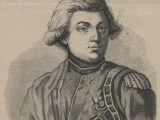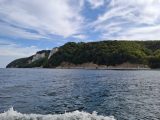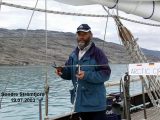Maurycy Beniowski was born in Hungary in 1746. Most researchers consider him to be Hungarian while others see him as Slovak. Hungarian heraldists point to many connections between his family and Polish families. Beniowski himself, in his Memoirs, calls Poland his homeland of choice and himself a Pole. He was a participant in the Polish Bar Confederation (1768 – 72) directed against (generally speaking), the establishment of a Russian protectorate over Poland. These were the times of the reign of Tsarina Catherine II. During one of the battles that the confederates fought against the Russians, he was taken prisoner, in May 1769. After various peregrinations, he was sentenced to exile to Kamchatka, where he arrived with other exiles in December 1770. In Bolszeretsk, the seat of the Kamchatka governor, he organised a conspiracy of exiles resulting in the seizure of the largest hunting ship in the harbour, the “St Peter and St Paul”, on which they escaped (86 persons) from Kamchatka on 12 May 1771. After more than four months, they sailed to the Portuguese enclave in China, Macao, on 22 September. The ship sailed under the flag of the Bar Confederation. In Macau, the ship was sold and Beniowski and part of the crew on a French ship, already as passengers, went to Europe, to France. In Paris, at the court of Louis XV. he gave an account of his peregrinations. The stories of his sensational escape from Russian exile and his sailing through the unknown Bering Sea, the North Pacific, etc. aroused great interest in Europe.
In the Memoir, we read that after leaving Kamchatka, the newly freed exiles went first to Bering Island. Here they met another fugitive, Mr Ochotin (he claimed to be German), whose influence extended as far as the Aleutians. From there, they sailed north to the Chukotka Peninsula and the Bering Strait. Here, the ice prevented them from going further north – it was only May. Why did they sail north? Beniowski did not want to do so at all, but succumbed to pressure from the crew, who feared the hot climate to the south, and thought that the so-called Northeast Passage would be kinder to them. It is true that the passage had not yet been sailed through in its entirety, but it had been known since the time of the second Bering expedition that it existed, albeit not particularly seaworthy. What the escapees knew about it, we do not know. It was a very diverse company both in terms of nationality, general knowledge, social background and gender. Only when they saw first-hand the danger and futility of sailing between the ice floes did they approve of the change of course. Now heading SE, they reached St Lawrence Island, unknown to Europeans.
After a cursory survey of the island, they sailed on in the same direction to the Alaskan coast. Along the way, Beniowski made sketches of the coastline, both indicative views (quite similar to those we know from the location books) and navigational charts. Sailing along the Alaskan coast, they reached the Aleutian Islands. Contacts with the local people were facilitated by a letter from Mr Ochotyn, whose influence and collations extended that far. They also met with – already there – Russian sea otter fishermen. The furs extracted from these animals guaranteed a profit of crores, especially on the Chinese market. They then sailed SW along the Aleutian Islands (following the advice of local pilots), through the Kurile Islands Japan and Taiwan/ Formosa, (which was not yet colonised by the Chinese at the time), to China. The journey was far from boring. Sailing through new bodies of water was a challenge, leading such a large, diverse crew was quite a challenge for Beniowski, and then there was the confrontation with new peoples (the Aleuts, the Aynesians – the Kuriles, the Japanese, the natives of Taiwan and finally the Chinese). It was only in Macau that they met representatives of various European countries.
The areas north of Japan were almost unknown to Europeans, and Japan was also very reticent in its dealings with European sailors. The exceptions were the Portuguese, who were allowed to use the port of Nagasaki.
Vitus Bering, who died on the island named after him in 1741, saw neither St Lawrence Island nor the Alaskan shores surrounding the Bering Sea to the east. Captain Cook did not appear there until seven years after Bering. It is almost certain that Joseph Banks, (a participant in Captain Cook’s first expedition and now President of the Royal Society) relied on Beniowski’s account when writing the assumptions for Cook’s third expedition.
From the moment Beniowski appeared in Paris with other convicts, including Russians, Russia made every effort to discredit him and portray him as a blagger.
Of course, his successful escape from exile did not bring glory to Russia, but worst of all was the exposure of a ‘gold mine’ (fur) in the Aleutians, and the description of a body of water to which the Russians laid claim. Beniowski’s accounts caused them to ‘vehemently’ start publishing the once-secret but not highly accurate maps in a bid to stamp their precedence. Beniowski, after all, revealed material from Catherine II’s ‘secret expeditions’ directed east and south of Kamchatka. Concerned about Russia’s presence in this part of the world, other claimants set off on expeditions. The Spaniards (from Mexico), for whom ‘their’ California stretched from Mexico far north to the Alaskan borders, believed that this was their rightful territory assigned to them by the decision of Pope Alexander VI in the Treaty of Tordesillas (1493). The British had been seeking the Northwest Passage for years. Previous expeditions from the Atlantic side had not been successful, so it was decided to try the North Pacific side (Cook’s third expedition) and reserve this part of the world for themselves.
The first printing of the Memoirs in English was prepared by William Nicholson the writer and sailor. Many maps and sketches of Beniowski were appended to the text. The pages were already marked with the places where the relevant illustrations were to go. Unluckily, during the preparations, a fire unexpectedly broke out in the house of the engraver, Mr Heath. Many of the illustrations were irretrievably lost. Luckily, a few copperplates survived and were later used. Nicholson reports what methods he used to check the reliability of Beniowski. These are the method of internal and parallel records. Internal evidentiality, is the mutual correspondence of the facts presented in the text. In short, the odds, speeds and distances from this, etc., must agree. The geographic coordinates given must translate into reality. Nicholson writes – “I have seen no error of this kind in these Memoirs: they contain nothing that is wholly improbable or contradictory.” We further read that the bulk of his account is supported by parallel testimony. Not all of them, however. The report of Captain Cook’s third expedition describes an encounter with a Russian participant in the voyage of the Beniowski, Ishmailov, who in truth confirmed his participation in the voyage, but was very mistaken in his testimony.
Following the publication of the English first edition, the Memoirs were printed dozens of times in various languages. In Germany, for example, there were as many as 10 editions. The translation was done by Danzigers, the Forsters (father and son), participants in Cook’s second expedition. Based on them, August von Kotzebue, a theatre director, developed and staged the play Count Beniowski, or Conspiracy in Kamchatka. Tsarina Catherine, through the governor of Reval (today Talin), tried to influence Kotzebue to abandon the staging of this play. He did not abandon it and suffered the consequences of this insubordination for a long time to come.
I wrote my above study based on two works by Edward Kajdansky. The first edition of his translated Memoirs (596 pages) and his book “The Mystery of Beniowski” (486 pages).
Mr Kajdansky did a benedictine job of translating and analysing the Memoirs, checking their consistency and comparing them, like Nicholson, with external sources, including Russian ones.
The Russian members of the conspiracy who reached Paris with Benniovsky were offered a pardon by the Russian ambassador and returned to ‘Matushka Rasia’. Seventeen returned. Three of them: Stepanov, Riumin and Ryazanov, wrote reports on the journey, but despite all the campaign against Bennikovsky, even these reports were not published in full, only specially compiled extracts. Why? – Because they too confirmed what Russia did not want to reveal at all costs. Until Beniowsky’s escape, no one in Europe knew that most of the valuable furs shipped to China and Europe, did not come from Siberia, whose belonging to Russia no one questioned (except perhaps its indigenous inhabitants), but from the islands in the Bering Sea, which theoretically stood open.
The published excerpts from Russian studies, challenged Beniowski’s truthfulness and denied sailing the Bering Sea and visiting the Aleutians, Russia’s ‘gold mine’. These reports, even though they failed the test of internal record-keeping, still did their job of spreading disinformation. The results of this can be observed even today, e.g. by snooping around on the internet and some Polish book publications, e.g. Janusz Roszko’s ‘Avanturnik nieśmiertelny’ published in 1989. During Soviet times, Polish writers followed in the footsteps of their ‘brothers’ and published their studies based on Russian reports, portraying Beniowski as a blagger. There are many examples of this hybrid warfare, which began as early as the 18th century and perhaps even earlier.
Beniowski and Madagascar.
As I have already written on the way to Macau, the Beniowski visited many places. After leaving Japan, the ship was found to have a leak and was taking on a great deal of water. It was even reckoned to be lost when, from a stork’s nest, a sailor reported seeing land. This land turned out to be the island of Riukiu, belonging to an archipelago stretching between Japan and Taiwan and which now belongs to Japan.
Beniowski established very friendly relations with the local people. His crew also liked it very much and five of them expressed a desire to stay there. Beniowski was also thinking of doing so, but first he wanted to sail to Europe, so that he could return with the equipment and supplies necessary to establish a colony and have the protector state behind him. From Riukiu, they sailed to Taiwan. Here he was first drawn into the local conflicts. He stood up for what he called a just cause, as he stood up with the locals against the outsiders. His involvement resulted in his decision to return and establish a colony – Taiwan is much larger than the island of Riukiu, and as they lie close together one did not exclude the other. He had already written the so-called ‘business plan’ for this venture before arriving in France.
On their way from Macau to France, they visited Ile de Frence, now Mauritius, and Madagascar.
In Paris, it turned out that France was not interested in distant Taiwan, but Madagascar was. Beniowski obtained the necessary plenipotencies and sailed for Madagascar. However, the project proved difficult to carry out. The planters of Ile de France regarded Madagascar as a source of slaves, while Beniowski, wanted to establish a colony under the protection of France, where there was freedom of religion, and postulated that “the protection of France would defend the rights and provide the slaves with the opportunity to reach the rank of free citizens by means of work and industry”. – This was a huge contradiction of interests. Beniowski’s story in Madagascar is colourful. The local people called him Ampanskabe (something like a king). However, developments were not to the liking of the established planters of the Ile de France and, as a result of a rather complicated intrigue, he was pacified by the French and died in Madagascar 1786.
Beniowski’s stay in Madagascar was divided into two periods, and between one and the other he tried to be helpful in the struggle for American independence.
Now, as a reminder, a few facts about the Confederation of Bar, which had a fundamental impact on the fate of our hero. Of course, it is easiest to read what is written about it in Wikipedia.
Below I make a kind of extract of the causes and course of the Confederation.
The Bar Confederation (1768-1772) – an armed union of Polish nobility formed in Bar in Podolia on 29 February 1768 in defence of the Catholic faith and the independence of the Republic of Poland, directed against: the protectorate of the Russian Empire, King Stanisław August Poniatowski and the Russian army supporting him.
The aim of the confederation was to abolish the laws imposed by Russia, especially those providing equal rights for other believers.
The Russian-imposed candidate for the Polish throne, Stanislaw August Poniatowski, began political changes in 1764 that broke with the previous system of noble democracy.
In 1767, 20,000-strong Russian troops entered the borders of the Polish Lithuanian Commonwealth, under the protection of which, on 20 March 1767, the Russian deputy Nikolai Repin formed various confederations. In response to these events, the Catholic nobility, influenced by Repnin, formed the Radom Confederation, directed against Stanislaw Augustus. Repnin, skilfully directed its blade against the person of the king, chessing Poniatowski and forcing him to do the will of Catherine II.
On 24 February 1768, the Republic signed a treaty of perpetual friendship with Russia, by virtue of which it became a Russian protectorate. Catherine II guaranteed the inviolability of the country’s borders and internal system.
On the eve of these events, the main leaders of the Bar conspiracy left Warsaw.
The General Confederation was founded in Bar on 29 February 1768, and was directed against the dissenters, the Russian Empress Catherine II and her submissive King Stanisław August Poniatowski.
On 23 March 1768, a resolution was passed at the Senate Council to call in Russian troops to suppress the Bar Confederation. Only 14 senators voted in favour. Stanislaus August Poniatowski was prepared to sign the Senate resolution even against most senators, in order to show his zeal and unshakeable loyalty to Russia.
On 25 September 1768, the Ottoman Empire actually declared war on Russia under the pretext of demanding that Russian troops leave Poland. Nikolai Repin donated 5555 ducats (100,000 Polish zlotys) to the Knights’ School to stop its cadets from participating in the Bar Confederation.
On 17 February 1770, the Bishop of Poznań, Andrzej Stanisław Młodziejewski, inspired by a Russian deputy, issued 2 pastoral letters in which he denounced as traitors to religion and the homeland all those who would dare to doubt the good and holy intentions of the King and share the opinion of the Bar Confederates.
On 16 May 1771, King Stanislaus Augustus concluded a treaty under which the commander of the Russian army in Poland, General Iwan Wymarn, and Franciszek Ksawery Branicki, at the head of the royal court regiments and part of the guard, were to fight together against the confederates. The king received monetary subsidies for this purpose from the Russian ambassador Kasper von Saldern.
The Bar Confederation was in decline.
In 1772, Antoni Barnaba Jablonowski, deputy of the General of the Bar Confederation, went to Vienna to conduct negotiations to save Poland. It was already too late. The first partition of Poland had already been decided.
Casimir Pulaski, despite his young age (24), was the leading military commander of the Bar Confederation. After its fall, he emigrated to France.
Benjamin Franklin, who met Pulaski in Paris wrote such to George Washington:
“Count Pulaski of Poland, an officer well known throughout Europe for his courage and struggle for the freedom of his country against the superior forces of Russia, Austria and Prussia, may be of great use in our service” Paris 29 May 1777.
Pulaski fought in the ranks of the United States Army from 1777 to 1779.
On 11 September 1777, at the Battle of the Brandywine, his bravery saved the life of Geoerg Washington, for which the latter, on 15 September 1777, promoted Pulaski to the rank of brigadier general of the US cavalry….
Pulaski died on 11 October 1779 from wounds received during the siege of Savannah.
A witness to his death, North Carolina State Surgeon General Dr Fayssoux, wrote of it as follows: “Pulaski had the consolation that in his last moments he was cared for by a fellow countryman, a relative, a friend, a confederate comrade from fighting for the common cause of their common fatherland. Count Beniowski was recognized by the dying hero as a relative and heir”.
I think that the above historical reflections on events over 2.5 centuries ago are still interesting, not to say topical.


